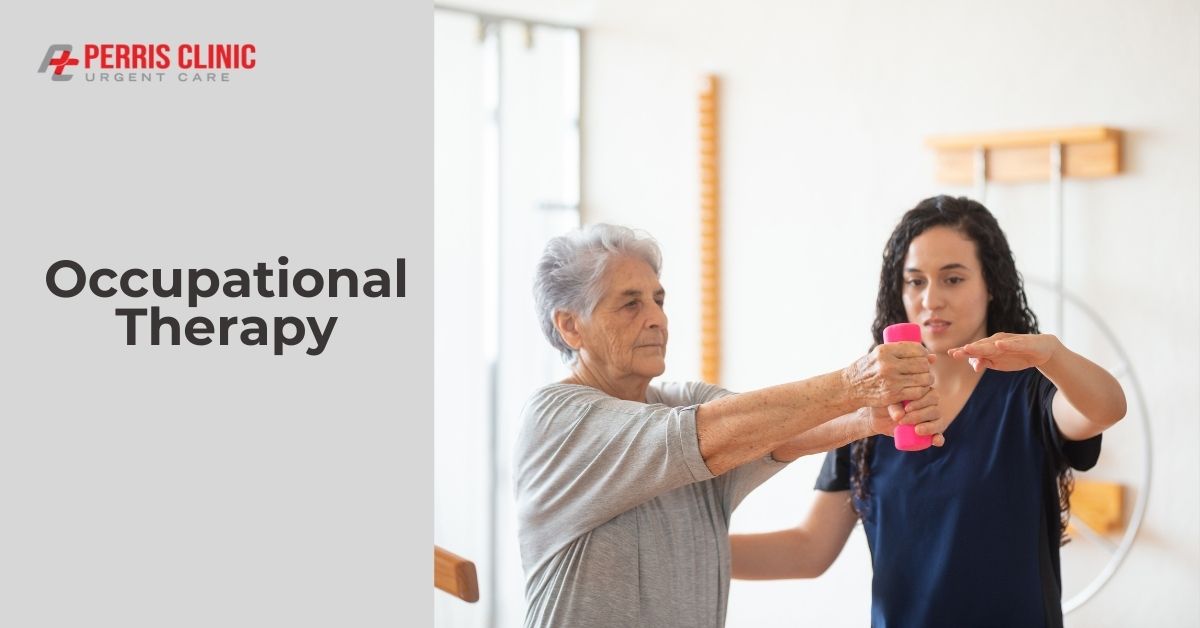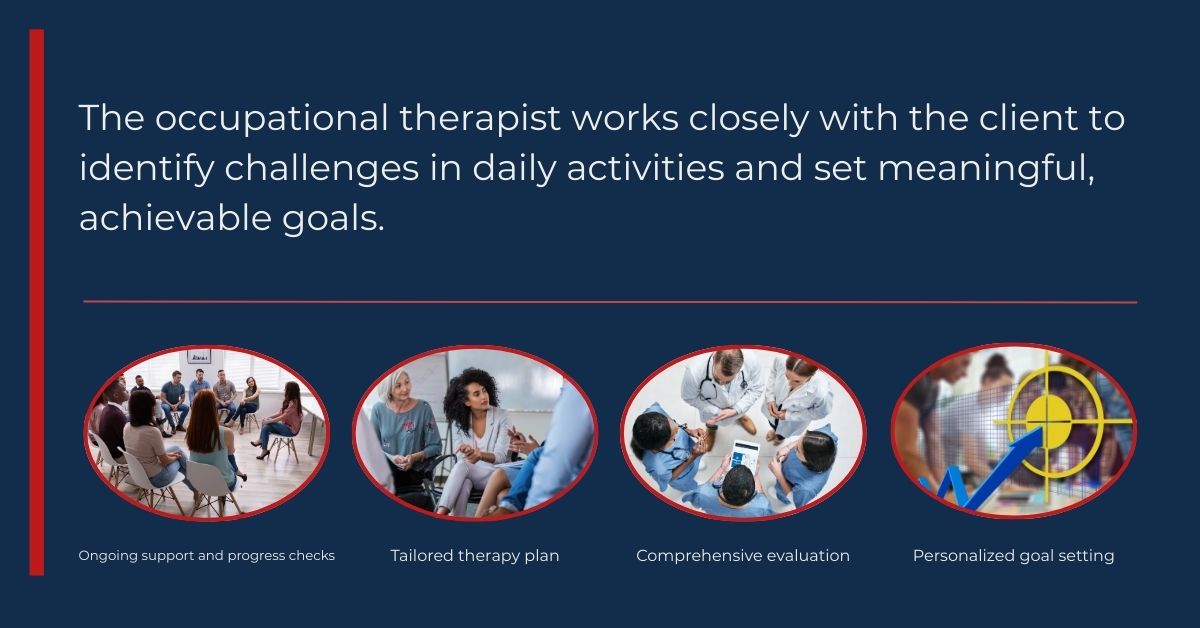When most people hear the term “occupational therapy,” they often think of children or rehabilitation for injuries. But occupational therapy (OT) is also a valuable support for adults facing everyday challenges, physical, emotional, or cognitive.
Whether you’re recovering from surgery, living with a chronic condition, or just struggling to keep up with daily tasks, OT can make a big difference.
Whether someone is recovering from an illness, managing a chronic condition, or simply struggling with everyday tasks, OT can be life-changing. At Perris Clinic, we’re passionate about helping adults live fuller, safer, and more independent lives.
In this post, we’ll explore the most common reasons adults are referred to occupational therapy and how it helps them regain independence, confidence, and control over their daily lives.
What Is Occupational Therapy?

Occupational therapy (OT) is a type of healthcare that helps people do the everyday activities that matter most to them, whether that’s getting dressed, making meals, going to work, or enjoying hobbies. It’s not about finding a job (even though it sounds like it). Instead, the word “occupation” refers to the daily tasks and roles that give your life purpose.
For adults, OT focuses on helping people:
- Regain independence after illness or injury
- Manage chronic conditions like arthritis or stroke
- Adapt to physical or cognitive changes
- Improve mental health and build healthy routines
- Stay safe and active in their home and community
Occupational therapists consider the whole person, including their environment, habits, challenges, and goals, to create personalized strategies that enable individuals to live fuller, more satisfying lives.
Before reading this blog post, see our previous blog post about the Advantages and disadvantages of occupational therapy, which helps you to make informed decisions about whether it’s the right fit for you or your loved ones.
Why Adults Get Referred to Occupational Therapy?
Many adults come to us through referrals from doctors, specialists, caregivers, or even concerned family members. Sometimes, individuals self-refer when they notice symptoms such as decreased mobility, memory problems, or difficulty managing daily routines.
Here are the most common reasons for OT referrals at Perris Clinic:
Recovery from Injury or Surgery
After an injury, such as a broken arm or surgery like a hip replacement, people often struggle to perform everyday tasks, like buttoning a shirt, bathing, or preparing meals. OT helps them recover strength, rebuild movement patterns, and relearn those daily skills.
Stroke and Other Neurological Conditions
Stroke survivors often lose partial control of one side of their body or experience memory and attention problems. Occupational therapists help clients retrain their brains and bodies to adapt, guiding them in exercises, using assistive tools, or developing new routines.
Other conditions like Parkinson’s disease, multiple sclerosis, or ALS can also impact how someone lives day to day. OT can help them stay independent for as long as possible.
Chronic Pain and Arthritis
Living with ongoing pain can make even simple tasks feel exhausting. OT provides pain management strategies, teaches joint protection techniques, and recommends adaptive equipment to make everyday life easier.
Mental Health and Emotional Well-Being
Mental health challenges like depression, anxiety, or PTSD can disrupt daily life. You may struggle to maintain a routine, feel unmotivated, or find it challenging to care for yourself. Occupational therapists work with clients to rebuild daily structure, increase engagement in meaningful activities, and support emotional regulation, all of which contribute to improved overall well-being.
Cognitive Decline or Brain Injury
Adults facing memory loss, early-stage dementia, or recovering from a traumatic brain injury may have difficulty with tasks that used to come naturally. OT provides strategies for improving memory, attention, and organization, such as using checklists, apps, or simplified routines.
Aging and Fall Prevention
As we age, our risk of falling increases. OT helps with fall prevention, balance training, and home modifications (like installing grab bars or using non-slip mats). These steps can help reduce the risk of injury and support safe, independent living.
Work-Related Challenges
Injuries, repetitive strain, or burnout can make returning to work difficult. OT helps clients adjust workstations, use ergonomic tools, and gradually build back their capacity. Therapists also help with stress management and productivity strategies.
Trouble with Activities of Daily Living (ADLs)
If someone is having trouble cooking, dressing, bathing, managing money, or driving, that’s a strong sign they could benefit from OT. Therapists break down these tasks, build up the necessary skills, and often suggest adaptive methods or tools.
What Happens After a Referral?

After a referral to occupational therapy, the process begins with a thorough evaluation to understand the individual’s physical, cognitive, and emotional needs.
The occupational therapist works closely with the client to identify challenges in daily activities and set meaningful, achievable goals. A personalized therapy plan is then created, focusing on improving independence, safety, and quality of life.
Once someone is referred for OT, here’s what they can expect:
- Comprehensive evaluation: We assess your physical abilities, cognitive skills, emotional health, and goals.
- Personalized goal setting: Therapy is based on what matters most to the client.
- Tailored therapy plan: We create a step-by-step plan to help individuals regain independence and function effectively.
- Ongoing support and progress checks: Therapy is flexible and adapts to your journey.
Read more: An occupational therapist helps children build daily life skills through play, movement, and sensory activities, supporting their growth, independence, and confidence in everyday tasks.
When Should You Consider Occupational Therapy?
You don’t need to wait until something serious happens to benefit from OT. Consider a referral if you or someone you love:
- Has increasing difficulty with self-care or home tasks
- Is recovering from a stroke, surgery, or injury
- Has a chronic condition affecting daily life
- Is showing signs of memory issues or confusion
- Is at risk of falling or has fallen recently
- Struggles with mental health and motivation
How Perris Clinic Can Help?
At Perris Clinic, our occupational therapists understand that no two people are the same. We offer compassionate, one-on-one therapy to help adults live better, safer, and more fulfilling lives. Whether you’re concerned for yourself, a parent, or a patient, we’re here to help.
FAQs: Common questions, People also search for
Q: Do I need a doctor’s referral to start occupational therapy?
In many cases, a referral from a physician is required, especially if you plan to use health insurance to cover therapy costs. However, some services may be accessible through self-referral, depending on your location and specific needs. At Perris Clinic, we’re happy to help you navigate the referral process and determine the best course of action for your situation.
Q: How long does an occupational therapy program typically last?
The duration of occupational therapy varies based on your condition, goals, and progress. Some clients achieve their goals in just a few sessions, while others may benefit from ongoing therapy over several weeks or months. Your therapist will continually assess your progress and adjust the treatment plan as needed.
Q: Is occupational therapy covered by insurance?
Yes, occupational therapy is generally covered by most major insurance providers when deemed medically necessary. Coverage may vary depending on your plan; therefore, we recommend checking with your insurance company for specific details. Our administrative team is also available to assist with benefit verification and authorization before your treatment.
Q: How is occupational therapy different from physical therapy?
While physical therapy focuses primarily on improving movement, strength, and mobility, occupational therapy is centered on helping individuals perform everyday tasks, such as dressing, bathing, cooking, or managing a home or job. Both therapies often complement each other and can be used together for comprehensive rehabilitation.
Q: Can older adults truly benefit from occupational therapy?
Absolutely. Occupational therapy is especially beneficial for older adults. It supports safe aging in place, reduces fall risks, enhances mobility, and empowers seniors to maintain independence in their daily routines. Whether managing chronic conditions or recovering from a recent health event, OT can significantly improve the quality of life for aging adults.
Q: Do I need a doctor’s referral to see an occupational therapist?
Not always. While some insurance plans require a referral, others allow self-referral. Contact us, and we’ll help clarify the details based on your specific situation.
Q: Is OT only for older adults?
Not at all! Adults of any age can benefit, especially those recovering from injury, dealing with chronic illness, or navigating life changes.
Q: What’s the difference between occupational therapy and physical therapy?
PT focuses more on physical movement and recovery. OT helps you apply those abilities in daily tasks, from getting dressed to cooking or working.
Q: How long does occupational therapy take?
It depends on your goals and needs. Some people come for just a few weeks, while others continue for longer to receive ongoing support.
Final Thoughts
Occupational therapy is all about helping you live your life to the fullest, no matter what challenges you’re facing. Whether it’s recovering after a stroke, managing chronic pain, or navigating everyday routines, OT can empower you or your loved one to feel more independent, capable, and confident.
If you’re curious about how OT could help or if someone you love might benefit, we’re here to help. Contact us at Perris Clinic today to learn more or schedule a consultation.
👉 Contact us at Perris Clinic today to learn more or schedule a consultation.


Trackbacks/Pingbacks